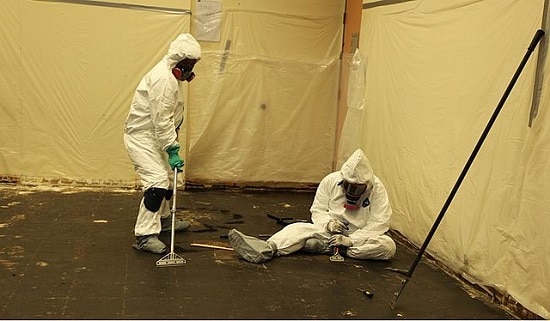Professional Asbestos Management is Essential, Here’s Why
There are many aspects involved in professional asbestos management. We discuss many of these aspects here so that you can bring a professional approach to your organisation.
A background to asbestos
Asbestos is a carcinogenic fibrous mineral found in an array of building materials. Problems with asbestos arise when such materials are disturbed or damaged and no asbestos management plan is in place, for example during building or refurbishing work, as the fibres in these products inevitably become released into the air.
Asbestos health-related risks
If left alone and undisturbed, asbestos does not pose an immediate threat. However, it is often the case that when building or refurbishment work takes place on a property that has been built or refurbished before the year 2000, any asbestos present can be disturbed or damaged. This can pose an immediate threat of exposure to those in the near vicinity.
Airborne asbestos fibres are microscopic in size and can embed themselves into the lining of a person’s lungs. It is never immediately apparent that a person exposed to asbestos has inhaled these fibres because they are invisible to the naked eye and have no fragrance and, after exposure, the symptoms can take many years to develop fully (usually 15+ years).
Prolonged asbestos exposure can result in serious lung problems, and in some cases can be fatal, leading to excruciating and painful asbestos diseases such as mesothelioma, lung cancer, and asbestosis, which are all terminal conditions.

Asbestos Management
Asbestos - a brief history and the UK 1999 ban
Asbestos has been used from the 1950s through to the 1980s due to its relative cheapness and its effective insulating properties, for example, asbestos insulation was widely used in house building. Therefore, there is a possibility today that numerous buildings may still contain traces of asbestos in many of their current building materials.
The use of asbestos in any building product was banned in 1999, as reported cases of the effects of continuous exposure came to the attention of the medical world and its toxic chemical qualities were exposed. Scientists then announced that even a small amount of fibre posed a great threat.
Where can asbestos be found?
It is possible to find asbestos in both industrial properties, such as factories, offices, shops, restaurants and even schools, as well as residential dwellings such as homes, sheds, and other outbuildings.
Responsible asbestos management
If an owner is planning on undertaking work in a building with any possible suspicion at all of the asbestos being present, in particular, that of one built or refurbished before the year 2000, it is imperative that the appropriate precautions should be taken which allow the affected areas to be identified and its condition determined.
Once asbestos is discovered in any property, it is the owner’s sole responsibility to act under the laws surrounding its successive treatment, because failing to do so ultimately puts the lives of those working around the infected areas at risk, as well as the immediate environment.
Any person attempting to knowingly remove and dispose of asbestos without the appropriate licence risks hefty prosecution through negligence. Additionally, if asbestos is uncovered during building work without prior knowledge of its existence, all work needs to be stopped immediately, and the area should be contained and evacuated while expert help is sought. The inherent dangers, both actual and legislative should be taken into account when considering asbestos plan requirements.
HSE managing asbestos – step by step approach
The HSE have published a wonderful guide entitled “Managing My Asbestos”. We encourage all property owners with a concern about asbestos to read this guide, by clicking here. The sections of this are:
- Introduction
- Are you responsible?
- When was it built?
- Information available
- Inspect your building
- Determining priorities
- Types of asbestos
- Write your plan
- Testing for asbestos
- Communication
- Getting work done and
- Records updating
Asbestos management plan
We, in particular, discuss “section 8 – Write Your Plan”, here. The old age “Fail to plan, plan to fail” definitely applies here. A comprehensive approach to planning, which is followed throughout the project lifecycle maximises the chance of success. In the asbestos management plan, organisations need to document:
- who is responsible for managing asbestos?
- a register of asbestos issues in a property, or portfolio of properties
- plans for any proposed works on areas with asbestos contamination
- a schedule for monitoring the condition of asbestos-containing materials
- communication structure and informing people about decisions
For further information, read our article, “An Asbestos Management Plan – When you Might Need One”.
Choosing the right asbestos removal company
Section 9 covers “Testing for asbestos”, this is effectively through asbestos surveys.
The first step after writing the asbestos management plan in dealing with asbestos involves undertaking an asbestos survey of the area. This will identify the exact location of asbestos while also determining the extent of the problem and allow you to analyse your asbestos management plan requirements. Only an approved asbestos management company will be qualified to perform such a task.
Section 11 covers “Getting work done”, this necessitates choosing an asbestos services company as a partner.
The need for a HSE licence
Such a company will, therefore, hold an HSE licence. This is a licence issued by The Health and Safety at Work Act which certifies that the company is legally allowed to identify and remove asbestos in conjunction with required regulations and to a clear asbestos action plan.
A reputable company should be able to provide this certification upon request while being clear and transparent about its asbestos handling experience and credentials, should they be required. They should also offer an opportunity to discuss their findings and preventative measures that they are intending to take, keeping those involved in the project informed at all times.
Specific training and PPE required
Asbestos management is an extremely hazardous job that requires specific training and the use of protective equipment (PPE) to ensure its safe removal with no harm or threat posed to the population or the environment. Knowledge and safety of asbestos removal processes are therefore paramount, and only fully reputable and licensed companies should be sought to undertake such work. If you follow the advice in this article, you will be practising a professional approach for asbestos management in your organisation.
Contacting Safeline Environmental
Please do not hesitate to contact Safeline Environmental for advice and how to implement a successful approach to professional asbestos management. Why not contact us to book or discuss one of our asbestos-related services? Contact methods are:
- Telephone - 01299 251083
- Email - info@safeline-env.co.uk
- General contact information - https://www.safeline-environmental.co.uk/contact/

